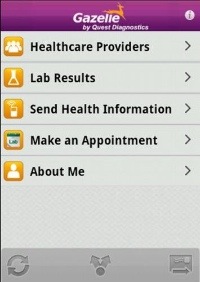 One-half of the members of Kaiser Permanente use the plans’ personal health record system, MyHealthManager. The most-used function of MyHealthManager is accessing lab results, according to KP.
One-half of the members of Kaiser Permanente use the plans’ personal health record system, MyHealthManager. The most-used function of MyHealthManager is accessing lab results, according to KP.
Now that Quest, the lab and health information company, has launched the mobile phone app, Gazelle, more health citizens will have access to lab test results. This could be a health-activating opportunity inspiring patient engagement.
While Gazelle is a fully functional personal health record (PHR), it’s the connection to lab test results that’s the lightbulb moment. PHRs have been available to health consumers for over a decade. There are millions of users of PHRs at KP, as well as in Group Health Cooperative’s GHCMyChart, and the VA’s My HealtheVet. Microsoft HealthVault has also gained traction with some patients, where some pioneering health providers are connecting for health such as at the Cleveland Clinic, among other sites.
But the fact that lab tests done through Quest can get sent directly to a patient’s mobile device could be a moment-of-truth in getting people (1) knowing their numbers and (2) getting more health-engaged. That is, if the KP experience translates to the general public.
Health Populi’s Hot Points: I got further introduced to Gazelle by Richard Schwabacher of Quest, who spoke at yesterday’s meeting of the Consumer Consortium on eHealth sponsored by the National eHealth Collaborative (NeHC). The meeting was attended by about 150 stakeholders representing interests in health technology, provider organizations, health advocacy, consumer advocacy, public sector, and academia. We came together to share best practices in patient engagement, to network, and to continue working together in ad hoc task forces to promote health engagement.
It was appropriate that Quest present the Gazelle app in this context. Lab tests are involved in at least 60% of medical decisions. In the emerging accountable care era, patients need to share in decision making with their doctors. That means patients need to knowing their numbers: what they mean, and how changing them can impact their future quality and length of life… where personal behavior change has the potential to do this.
Ultimately, the PHR should go beyond delivering data — which in itself, is necessary, but not sufficient, for providing the kind of feedback loops that inspire and sustain behavior change. I’ve seen many PHRs that might offer a clinical definition of a test result, such as LDL or bilirubin. But a scant few offer the kind of feedback loop that is the opportunity for a mobile app to offer: that is, to personalize what changing the number can do to one’s own quality of life. This would mean delivering high impact, engaging video and visuals that talk about lab numbers’ impacts on “the unmentionables,” as my friend and colleague Alexandra Drane of ELIZA Corp. defines them: sex, money, workplace stress, and other aspects of 3-D daily living.




 Thank you, Jared Johnson, for including me on the list of the
Thank you, Jared Johnson, for including me on the list of the  I am so grateful to Tom Lawry for asking me to pen the foreword for his book, Health Care Nation,
I am so grateful to Tom Lawry for asking me to pen the foreword for his book, Health Care Nation,  Thanks to Feedspot for naming this blog, Health Populi, as a
Thanks to Feedspot for naming this blog, Health Populi, as a